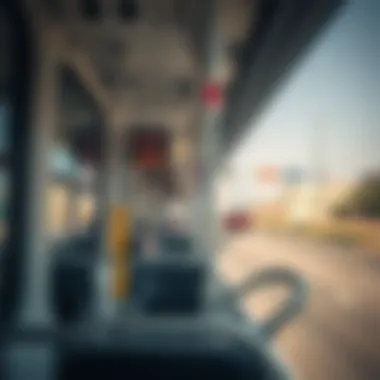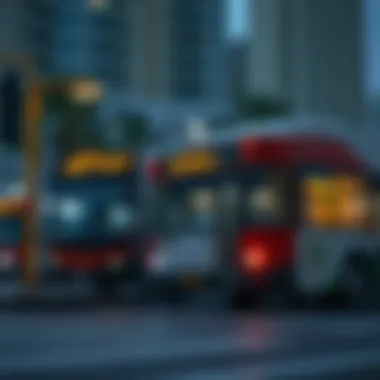Transportation Costs in Al Ain: A Comprehensive Overview


Intro
Al Ain, a vibrant city nestled in the United Arab Emirates, offers a unique blend of tradition and modernity. Understanding transportation costs in this region is crucial for both residents and visitors alike. This article blends deep insights with practical information to help navigate the often-complex world of travel within Al Ain, making it easier to plan your daily commutes or leisure trips. With everything from taxis, buses, and even riding camels making up this transport landscape, understanding the fare structures, key operators, and current trends ensures you won’t be taken for a ride—literally and metaphorically.
In this exploration, we’ll guide you through various dimensions of the transportation scene in Al Ain, examining not only the costs involved but also the significance of public transportation within the city. It’s essential for anyone living in or planning to visit Al Ain to grasp the implications of these costs on daily life, providing a solid foundation for informed decision-making regarding travel options.
Market Insights
Transportation in Al Ain is shaped by several factors, including the city’s layout, population density, and economic conditions. These elements come together to create a unique context for transportation trends and fare structures.
Current Trends in Al Ain Transport
One of the notable trends in Al Ain is the increase in the use of public transport. Municipal initiatives aim to encourage a shift from private vehicle dependence towards more sustainable modes of transport. This can be observed in the growing ridership numbers of buses and taxis, as residents and visitors seek cost-effective and efficient ways to get around.
Additionally, smart transport solutions are emerging, especially with the advent of ride-hailing apps like Careem which have transformed how people book rides. Fare transparency is also gaining traction, with more operators providing upfront pricing, thus enabling users to plan their expenditures better.
Key Economic Factors Influencing Travel Costs
Transportation costs are not only impacted by the way services are structured but also reflect broader economic conditions. The price of fuel, for instance, directly affects taxi fares. In the UAE, fluctuations in oil prices can lead to changes in pricing strategy among transport service providers.
Moreover, factors such as inflation, cost of living, and urban development projects can change how transportation fares are structured in Al Ain. This can be crucial for expatriates who may find variations in travel costs compared to their home country.
Overall, understanding these multidimensional market insights paints a clearer picture of how transportation economics work in Al Ain, offering a roadmap for users to navigate their options wisely.
Prologue to Transportation in Al Ain
Transportation serves as the lifeblood of any city, and Al Ain is no exception. As one of the principal cities in the United Arab Emirates, Al Ain boasts a unique blend of rich cultural heritage and modern amenities. Effective transportation networks can stimulate economic growth, foster connectivity, and enhance the overall quality of life for residents and visitors. This article aims to dissect the transportation landscape in Al Ain, particularly focusing on costs and how they impact both daily commuters and travelers. By understanding the fare structures and various transportation options available, readers can make informed choices when navigating this vibrant city.
Overview of Al Ain as a City
Al Ain is often referred to as the "Garden City" of the UAE due to its lush greenery and agricultural surroundings. Nestled near the border with Oman, it has a distinct identity, being the birthplace of many significant Emirati cultural figures. With a population exceeding 700,000, the city has steadily developed while retaining its traditional charm.
The city's mesmerizing landscapes are dotted with palm oases, museums, and historical sites. Roads snake through residential areas, leading to commercial hubs and multicultural neighborhoods, making efficient transportation essential for both daily life and tourism. Key roadways include Sheikh Zayed Road, which links major urban centers and facilitates easy access.
Importance of Transportation in Urban Development
In any urban setup, effective transportation systems hold undeniable significance. They not only connect neighborhoods but also enhance economic opportunities. When the transportation network operates seamlessly, it bolsters real estate values, attracts business investments, and promotes social interactions.
Key benefits of transportation in Al Ain include:
- Accessibility: An efficient transport system enables easy access to work, education, and healthcare facilities.
- Economic Growth: Improved connectivity leads to increased commerce, attracting both local and international businesses.
- Sustainability: Modern transportation options, such as buses and ride-sharing, can reduce carbon footprints and alleviate congestion.
Transportation, therefore, plays an instrumental role in shaping urban dynamics. It affects everything from property prices to the ease of travel. As Al Ain continues to grow, understanding its transportation landscape will be imperative for future development.
Transportation Costs in Al Ain
Understanding the transportation costs in Al Ain is vital for anyone navigating this vibrant emirate. Not just a mundane topic, the costs associated with moving from one spot to another can affect budgets, travel plans, and ultimately the livability of the city. Transportation in Al Ain isn't solely about getting from point A to point B; it's intertwined deeply with urban development, tourism, and the economy. By examining transportation costs, we uncover insights that serve both residents and visitors, enhancing their experiences while also informing their decisions.
Factors Influencing Fare Pricing
Distance
Distance plays a big role in determining fare prices in Al Ain. The longer the journey, the higher the cost, which is a standard practice seen in most transport systems worldwide. This system makes sense on a fundamental level: more distance often requires more fuel and time. What’s unique in Al Ain is how distances can vary dramatically, from short trips within the city to longer excursions to surrounding areas. A notable aspect of this is how familiar travelers become with the city. Regular commuters may find themselves favoring shorter routes to save money, while new residents or tourists might indulge in the longer drives to explore the area.


Contrarily, sometimes a longer trip might not be an option, especially if it’s rush hour. In the end, distance becomes a balancing act—saving time or money necessitates careful planning.
Type of Vehicle
The type of vehicle you choose can significantly impact your transportation costs in Al Ain. For instance, taxis, buses, and private cars each come with their own pricing structures. Taxis, which often come to mind first, generally charge based on both distance and time. The essential characteristic of taxis is their convenience. They’re available any time and subject to minimal wait times.
On the flip side, buses offer a more economical option though usually with longer waiting times and routes that might not be directly convenient. Lastly, private vehicles might be seen as a lavish choice, but owning your own ride can save money in the long run, giving you the freedom to explore without fare limits.
Time of Travel
Time of travel is another contributing aspect that many overlook. Fare prices can fluctuate depending on when you need to move. For example, during peak hours, taxi fares may increase while bus schedules might have limited availability, leading to higher demand for alternative transport (like ride-sharing services).
This variability can be frustrating, especially for those who work standard hours and need reliable methods of transportation. Zeroing in on not only the distance but also the time you choose to travel can aid in avoiding unwanted costs, making this a crucial consideration in planning your ventures around Al Ain.
Typical Fare Structures
Taxi Fares
Taxi fares in Al Ain come with a straightforward structure, primarily based on distance and starting fare. This clear pricing is a perk for those who prioritize predictability in their travel costs. Additionally, it's worth noting that taxis are incredibly popular among both residents and tourists. One major advantage is the convenience factor—there’s typically a taxi available around the corner, ready to whisk you away. However, the downside may be the expense associated with longer distances or peak times, which can take a bite out of even the most carefully planned budget.
Bus Fares
Bus fares provide a cost-effective travel method within Al Ain, catering to those who are budget-conscious. The allure of utilizing public transportation like buses does not only lie in cheap fares but also in contributing to reducing traffic congestion. However, the trade-off is the potential for longer travel times and the necessity for schedule awareness—missing a bus can throw a wrench in one’s plans.
Generally speaking, for tourists or new residents, becoming familiar with bus routes is a worthwhile endeavor. It opens up a world of possibilities while keeping costs in check.
Ride-sharing Services
Ride-sharing services have made quite an impact on transportation within Al Ain. Usually more convenient than a traditional taxi, they bring the added perks of mobile apps that allow for easy booking. Pricing typically varies, influenced by demand and the type of service selected. Yet, while ride-sharing can sometimes be more economical than taxis, during peak times costs can escalate, potentially surprising users.
For many in Al Ain, ride-sharing presents a flexible option that suits busy lifestyles and offers a sense of security—knowing where you’re headed, alongside the capability to split fares among multiple users, often translates to an appealing choice for both locals and visitors.
Public Transport Services in Al Ain
Public transport in Al Ain plays a vital role in shaping the commuting landscape of this vibrant city. As more people flock to Al Ain for work, leisure, or education, access to efficient and affordable transport becomes crucial for both locals and visitors. Public transport services among other aspects of transportation become the backbone of connectivity, bridging various districts and improving overall accessibility. The city's dedication to developing transport options showcases its commitment to sustainable urban development.
Overview of Available Public Transportation Options
Buses
Buses form the backbone of Al Ain’s public transport system. They serve as a primary mode of transportation for many residents. The extensive network covers major neighborhoods, offering affordable fares that cater to the average commuter. A key characteristic of the bus service in Al Ain is its frequency, helping reduce waiting times significantly. One unique feature of buses here is that they often have routes that connect to key locations like shopping centers, universities, and hospitals.
However, it’s important to know that while buses are cost-effective, they may not be the fastest option available. Moreover, during peak hours, buses can be quite crowded, which might be a drawback for those who prefer a more comfortable ride. Despite this, buses remain a popular choice due to their affordability and accessibility.
Trains
The train services in Al Ain, although still developing, are set to enhance the transportation landscape significantly. The current governmental push towards expanding rail connectivity will soon link Al Ain with neighboring cities and emirates. The key feature of trains is their speed; they are designed to cover longer distances in less time than traditional road transport.
The planned railway system is unique because of its environmental benefits. Trains produce lower emissions compared to cars and buses, making them a more eco-friendly choice. Once completed, this system will provide a significant advantage in reducing the traffic volumes on Al Ain's roads, benefiting both commuters and the environment alike. However, until the system is fully operational, train travel remains a concept that Al Ain residents look forward to for the future.
Dubai Metro connections
The connections to Dubai Metro from Al Ain add another layer of convenience for both residents and visitors. Travelling to Dubai for work or leisure has never been easier, thanks to this integration. The major characteristic of this connection is its reliability and comprehensive coverage, allowing for seamless travel across the emirates.


A unique feature of the Dubai Metro connection to Al Ain is how it promotes regional connectivity. It allows for quicker access to major attractions in Dubai, thus attracting tourists and business travelers alike. This can be a major advantage for expatriates looking to live in Al Ain but work in Dubai, as they can leverage this efficient transport link. On the flip side, the need for additional transport to reach the metro stations in Dubai could be a potential drawback for those not living directly along this route.
Efficiency of Public Transport
When it comes to assessing the efficiency of public transport in Al Ain, several factors come into play. The punctuality of services, ease of transfers between different transport modes, and overall access to primary destinations are critical for defining what makes a transportation system truly efficient. Although public transport in Al Ain has been making strides, ongoing evaluations are necessary to improve service quality and meet the growing demands of urban mobility.
Transportation for Tourists
When it comes to exploring a city like Al Ain, transportation plays a pivotal role in shaping a visitor's experience. The way tourists navigate through the various attractions not only affects their enjoyment but also influences their perception of the city as a whole. Efficient and diverse transport options contribute significantly to making travel less of a hassle and more of an adventure. Knowing the available transportation methods helps tourists plan their trips better and enhances the overall travel experience.
Available Options for Tourists
Airport Transfers
Airport transfers are vital for seamless travel when arriving or departing from Al Ain International Airport. These services often come with the convenience of door-to-door delivery, which means travelers can hop into a pre-arranged vehicle and bypass the initial confusion that can accompany foreign travel. One key characteristic of airport transfers is their reliability; they are typically arranged in advance, reducing wait times. This can be especially appealing for those who wish to start their holiday on a stress-free note.
A unique feature of airport transfers in Al Ain is the availability of a variety of vehicle options, ranging from standard sedans to larger SUVs, catering to different group sizes. However, this convenience comes at a cost; airport transfers can sometimes be pricier than other forms of transport, which might deter budget-conscious tourists.
City Tours
City tours offer a comprehensive way for travelers to familiarize themselves with Al Ain's rich cultural heritage and natural beauty. Many tour providers offer packages that cover major attractions like the Al Ain Oasis, the Sheikh Zayed Palace Museum, and the Al Ain Zoo, making it easy for tourists to see everything in a limited time. The key characteristic of city tours is their structured itinerary which maximizes sightseeing without hassle, making it a popular choice among tourists.
One unique feature of these city tours is the guided commentary, which provides insights into the history and significance of each location, deepening the visitor’s understanding. However, these tours may not appeal to those who prefer a spontaneous travel experience or hope to explore places at their own pace.
Rental Cars
Rental cars are an attractive option for tourists who cherish the freedom to explore Al Ain and its surroundings at their own pace. Having a vehicle can open the door to off-the-beaten-path destinations, making it possible to visit spots like the Jebel Hafeet mountain or the stunning Al Ain waterfalls. The key characteristic of rental cars is flexibility; they allow travelers to set their own schedules and routes.
However, a unique feature worth noting is the very local practice of driving, which might take some getting used to for international visitors. Additionally, costs associated with fuel, insurance, and parking can add up, so travelers should consider these implications when deciding on a budget.
Cost Implications for Tourists
The cost implications of transportation for tourists in Al Ain vary widely based on the chosen options. Airport transfers, while convenient, can often be among the more expensive choices to budget for. In contrast, utilizing public transportation or opting for city tours can offer more economical alternatives, although they may lack the same level of convenience or personalized service that one might experience with private transport.
Planning for transportation costs ahead of time can help to mitigate any financial surprises during the trip. By understanding the wide range of options available, tourists can ensure their travels not only budget-friendly but also enriching.
Challenges in Transportation
Transportation in Al Ain faces its share of hurdles that impact residents and visitors alike. Understanding these challenges is pivotal for anyone considering living or traveling in the city. A complex interplay of factors, such as traffic congestion and infrastructural limitations, can have profound implications on overall commuting experiences. Recognizing these issues contributes to smarter decision-making and investment considerations, particularly for investors, realtors, expatriates, homebuyers, and renters.
Traffic Congestion Issues
Traffic congestion is one of the most prominent challenges experienced in Al Ain. The rapid growth in population and economic activities has led to a surge in the number of vehicles on the roads. The current road infrastructure struggles to keep pace with demand, leading to long delays during peak hours. Local commuters often mention feeling like they're stuck in a gridlock, especially near major junctions and commercial areas.
The adverse effects of traffic congestion extend beyond mere inconvenience. Increased travel times can lead to higher operational costs for businesses and affect overall productivity. A lengthy commute can take a toll on mental well-being, creating frustrations that resonate across communities. Moreover, inadequate public transport options exacerbate this scenario, leaving many dependent on personal vehicles, which only adds to the problem.
Infrastructural Limitations
Infrastructural limitations are another notable challenge hindering effective transportation in Al Ain. While some areas boast modern roads and facilities, many parts of the city still reflect developmental gaps. Poorly maintained roads, lack of proper signage, and insufficient traffic management systems contribute to the chaos on the streets.
Investors may find these infrastructural constraints a double-edged sword. On one hand, there are opportunities to invest in developing more efficient transport solutions and improving existing road networks. On the other hand, the unpredictability of current transport systems can deter potential buyers and renters looking for ease of mobility. In addition, the lack of real-time information for public transport users can result in missed connections and wasted time.
"Effective transportation solutions in Al Ain require collaboration between government bodies and private investors to address these challenges strategically."


Both traffic congestion and infrastructural limitations serve as significant barriers to efficient transportation in Al Ain. Addressing these issues is critical for enhancing the quality of life for residents and ensuring that the city remains an attractive prospect for future investments. Navigating these complexities can yield insights that not only benefit current inhabitants but inspire improvements that stand the test of time.
Future Trends in Transportation
Understanding future trends in transportation is critical for assessing the long-term viability and adaptability of Al Ain's transport systems. As urban areas evolve, the need for innovation that addresses both demand and environmental concerns becomes paramount. Here are some key elements shaping the direction of transportation in Al Ain:
- Technological advancements that streamline operations and improve user experiences.
- Sustainability efforts that aim to reduce the negative impact of transport on the environment.
Technological Innovations
Electric and self-driving vehicles
Electric and self-driving vehicles represent a significant leap forward in the transportation sector. The primary characteristic of electric vehicles (EVs) is the use of electricity as a power source. This aspect contributes to lower running costs and reduced dependence on fossil fuels. For a city like Al Ain, where the air quality is crucial, adopting EVs offers a cleaner alternative to traditional combustion engines.
Self-driving vehicles introduce automation into the transit mix, providing a seamless and efficient travel experience. A standout feature is the ability to reduce human error in driving, which can lead to fewer accidents and increased safety on the roads.
While the advantages of these vehicles are clear—such as lower maintenance costs and greener operations—there are some hurdles as well. The initial investment for infrastructure, like charging stations, can be considerable. Additionally, there are legal and regulatory challenges that have yet to be fully addressed.
Smart traffic management systems
Smart traffic management systems utilize real-time data and algorithms to improve traffic flow and reduce congestion. A key characteristic of these systems is their ability to adapt to changing traffic patterns, which can lead to enhanced efficiency.
For Al Ain, such systems can significantly ease traffic woes, especially during peak hours. Features such as synchronized traffic signals and real-time rerouting can lead to shorter travel times and decreased fuel consumption.
However, while the benefits are clear, there are considerations regarding the upfront investment and the need for training personnel to manage these complex systems effectively.
Sustainability Efforts
Reducing carbon footprint
Reducing the carbon footprint of transportation is an essential goal for sustainable urban development. This concept emphasizes minimizing greenhouse gas emissions associated with transport activities. The importance of this effort is underscored by the rising global concern about climate change and its impacts.
By adopting cleaner technologies and improving public transportation, Al Ain can position itself as a leader in sustainability within the region. This not only benefits the environment but also enhances the quality of life for residents through cleaner air and less noise pollution.
Unique features of carbon reduction initiatives may include incentives for public transport use, as well as subsidies for electric vehicle purchases. However, challenges such as public awareness and the transition period for adopting new technologies must also be considered.
Increasing green transport options
Increasing green transport options is gaining traction as cities seek to diversify their transportation portfolios. This involves enhancing alternative modes of transport like cycling and walking paths, as well as promoting electric public transport vehicles.
One notable aspect of green transport is the emotional and physical health benefits it brings to the community. Options like biking not only reduce vehicular traffic but also encourage a more active lifestyle among residents.
The unique feature of expanding green transport options is how it aligns with community-building efforts, fostering connections among residents. However, successful implementation hinges on adequate infrastructure and continuous public engagement to encourage participation.
Adopting these future trends is vital for Al Ain to ensure efficient, sustainable, and user-friendly transportation systems that resonate with the needs of its diverse population.
Epilogue
Transportation costs in Al Ain offer a crucial insight into the city's infrastructure, accessibility, and overall functionality. Understanding these dynamics not only benefits residents but also plays a significant role for potential investors, realtors, expatriates, homebuyers, and renters. Evaluating transportation expenses is vital, as it can influence choices related to living areas, career opportunities, and even tourism.
Summary of Key Points
The exploration of transportation costs has highlighted several vital aspects:
- Fare Structures: The range of fares for taxis, buses, and ride-sharing services gives individuals options that can fit different budgets.
- Factors Influencing Costs: Variables like distance traveled, type of vehicle used, and timing greatly affect pricing. This knowledge allows for more strategic planning of one’s commute.
- Public Transport Services: The availability and efficiency of public transport options like buses play a significant role in reducing individual transportation costs, ultimately contributing to a more sustainable lifestyle.
- Challenges: Recognizing the challenges such as traffic congestion and infrastructural limitations provides context for future improvements.
- Future Trends: Anticipated innovations, such as electric vehicles and smart traffic management, underline the progressive steps Al Ain is taking to improve its transportation network.
Looking Ahead
As Al Ain continues to evolve, the future of transportation seems promising. Ongoing advancements in technology will likely improve efficiency and accessibility. Stakeholders can expect a gradual shift towards more environmentally friendly options, aligning with global sustainability trends. For investors and realtors, this indicates an evolving landscape where property values may be influenced by proximity to reliable and cost-effective transportation.
Additionally, as infrastructure develops, new avenues for tourism may open, enhancing Al Ain’s reputation. Staying informed about transportation changes and trends is essential for anyone looking to navigate the urban fabric of this fascinating city effectively. Embracing these shifts not only prepares residents for upcoming changes but also positions them to take advantage of new opportunities in Al Ain’s dynamic environment.















